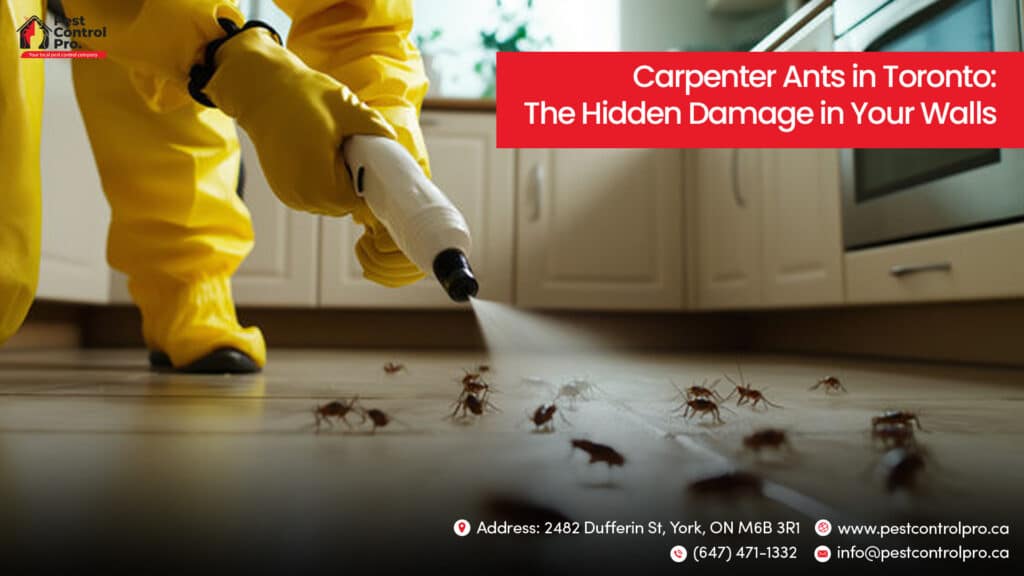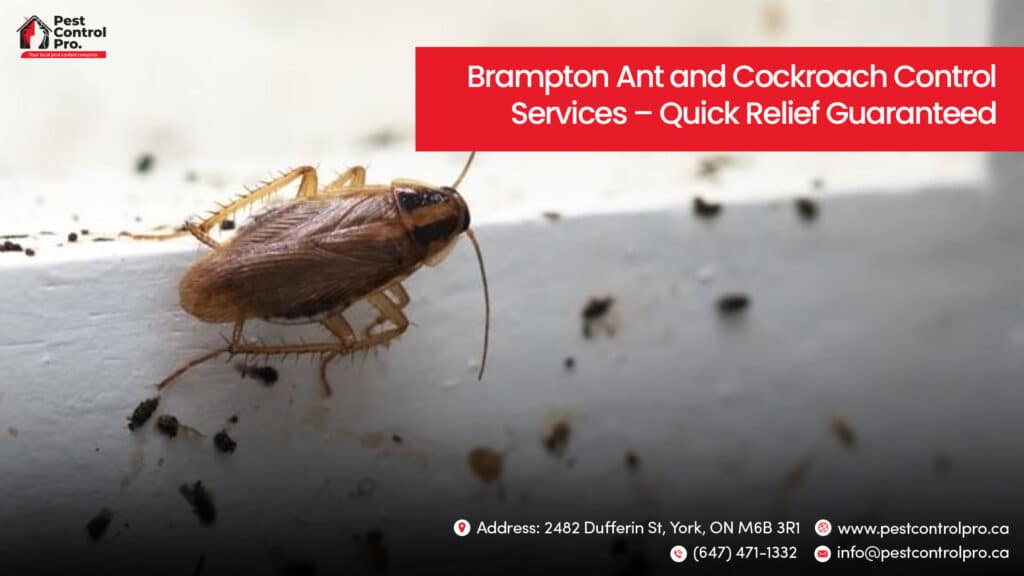Carpenter ants can cause serious damage in your Toronto home. These wood-destroying pests tunnel into structures, compromising the integrity of walls and beams. You might notice signs like sawdust, a rustling sound within your walls, or even winged swarmers during the warmer months.
To protect your home, it’s crucial to act swiftly. First, identify the source of the infestation. Look for nests in damp or decaying wood, as carpenter ants are attracted to moisture. Next, consider using bait traps or insecticides specifically designed for ants. These methods can effectively eliminate the colony and prevent future infestations.
A random fact: carpenter ants can excavate up to 30 feet of tunnels in just one season! This highlights the importance of prompt action. By addressing the issue early, you can save yourself from extensive repairs later on. Remember, maintaining a dry environment and sealing any entry points is key to preventing future problems. Your home deserves protection, so don’t wait—act now to keep those pesky carpenter ants at bay!
How to Identify Carpenter Ants
To easily spot carpenter ants, you should focus on a few key characteristics. First, these ants measure between 6 to 13 mm, making them larger than many common household ants. Their colors can include solid black, red, or reddish-brown. You’ll notice their segmented bodies have a narrow waist and distinct elbowed antennae.
A critical feature to identify is their evenly rounded thorax, which distinguishes them from other ants that have uneven thoraxes. Carpenter ants prefer nesting in damp or damaged wood, where they carve out tunnels.
Being aware of these traits is important, as ignoring a carpenter ant infestation can lead to significant structural damage over time. Interestingly, carpenter ants can remove up to 100 feet of wood in a single season when they’re active!
Common Signs of Carpenter Ant Infestations
If you suspect a carpenter ant infestation in your home, there are several signs to look out for. Identifying these signs early can help you avoid severe structural damage. Here’s what to watch for:
- Frass: This sawdust-like material found beneath wooden furniture or beams indicates that carpenter ants are tunneling through your wood. It’s a clear sign of their activity.
- Rustling Sounds: If you hear faint noises coming from your walls, especially at night, it could mean that these pests are busy excavating your wooden structures.
- Winged Ants: The appearance of swarmers, or winged ants, is a strong indicator of a significant infestation and the establishment of breeding colonies in your home.
Remember, carpenter ants can be quite destructive. Did you know that they can chew through wood up to 30 times faster than termites?
Acting swiftly is essential. If you notice any of these signs, consult a pest control professional to assess the situation and provide solutions.
The Damage Carpenter Ants Can Cause
Carpenter ants can cause serious damage to your home if you don’t take action. These pests create extensive tunnel networks by excavating wood. This weakens your walls and support beams over time.
Unlike termites, carpenter ants don’t eat wood; they remove it, leaving behind smooth, hollowed-out areas. These signs can indicate potential structural damage.
You might hear rustling sounds from within your walls or see sawdust, known as frass, beneath wooden structures. If you ignore these signs, a long-term infestation can lead to costly repairs that might reach into the thousands.
It’s essential to identify and eliminate carpenter ants quickly. Effective pest control will protect your home and ensure its longevity.
Did you know that carpenter ants can travel up to 100 yards from their nest in search of food? Stay vigilant and take action to keep your home safe!
Effective Extermination Strategies
To effectively eliminate a carpenter ant infestation, you need to adopt a multi-faceted approach that combines strategic measures and high-quality products.
DIY sprays often scatter the colony, making the problem worse. Instead, focus on these key steps:
- Inspect Thoroughly: Identify entry points and the specific ant species. This will help you understand their behavior and preferred nesting sites.
- Use Professional Products: Apply dusts, baits, and gels specifically designed to penetrate wall voids. These formulations are more effective for extermination than traditional sprays.
- Schedule Regular Inspections: Conduct seasonal checks to catch any potential reinfestations before they escalate.
Did you know that carpenter ants can create extensive networks of galleries within wood, leading to significant structural damage?
As a pest control professional, I assure you that addressing the issue promptly is crucial for maintaining the integrity of your home.
Prevention Tips for Homeowners
To prevent carpenter ant infestations in your home, you need to take some proactive steps. First, regularly inspect your space for signs of these pests, such as sawdust near wooden beams or furniture. This early detection can save you from larger issues down the road.
Next, seal any cracks or gaps around your foundation, windows, and plumbing. These small openings serve as easy entry points for carpenter ants.
Address moisture problems by repairing leaks and ensuring proper drainage, as these ants are particularly attracted to damp wood for nesting.
Maintaining cleanliness in your kitchen and pantry is also crucial. Store food in airtight containers and promptly clean up spills to minimize their appeal.
Lastly, consider scheduling seasonal inspections with a pest control professional. This proactive measure can help catch potential infestations before they escalate into serious structural damage.
Did you know that carpenter ants can remove up to 10 times more wood than they consume? By following these prevention tips, you can effectively safeguard your home from these destructive pests.
When to Seek Professional Help
Knowing when to seek professional help for carpenter ants is crucial. If you notice signs of a serious infestation, act quickly. Here are the main indicators that require expert intervention:
- Frass: If you see wood particles or frass near wooden structures, it indicates carpenter ant activity.
- Tunnels: Smooth tunnels or hollow spots in wood suggest significant damage to your home’s structure.
- Increased Sightings: A sudden rise in ant sightings across several rooms means you’re dealing with a widespread infestation.
DIY pest control often doesn’t cut it with these persistent pests. In fact, carpenter ants can cause extensive damage if left untreated.
As a pest control professional, I recommend reaching out for a thorough inspection and effective treatment. Protect your home from further destruction by taking action today!
Frequently Asked Questions
Can You Permanently Get Rid of Carpenter Ants?
Yes, you can permanently eliminate carpenter ants. First, identify their nests, which are often hidden in wood structures. Next, control moisture levels in your home since these pests thrive in damp environments. Lastly, make necessary structural repairs to eliminate their food sources.
As a pest control pro, I recommend combining professional extermination services with natural remedies. Baiting strategies can attract and kill ants, while consistent monitoring helps prevent future infestations. Did you know that carpenter ants can tunnel through wood, weakening structures over time? Taking action now can save you from costly repairs later. Remember, with diligence and the right approach, you can ensure a carpenter ant-free environment.
Do Carpenter Ants Damage Property?
Yes, carpenter ants can indeed threaten your home. These pests damage wood as they create nests, leading to structural problems over time. Their nesting habits involve hollowing out wood, which can weaken beams and other vital supports. Recognizing signs of infestation, such as sawdust and frass, is crucial for early intervention.
Interestingly, carpenter ants are more active in warmer months, particularly in spring and summer. As a pest control professional, I recommend regular inspections to catch any issues before they escalate. Effective pest control measures can help maintain your home’s integrity and save you from expensive repairs down the line. Always stay vigilant!
How to Get Rid of Carpenter Ants in Toronto?
To eliminate carpenter ants in Toronto, start by identifying their colonies and nesting behaviors. First, locate the nests. Carpenter ants prefer damp, decaying wood, often found in basements or near moisture sources.
Next, set effective traps. You can use bait traps specifically designed for ants, which will attract and kill them. Additionally, consider DIY solutions like a mixture of sugar and borax, which can be an effective remedy.
For a more natural approach, diatomaceous earth can help deter ants. Sprinkle it around entry points and nests to disrupt their bodies.
If the infestation is severe, don’t hesitate to call in professional exterminators. They have the expertise and tools to tackle the problem thoroughly.
Finally, practice prevention. Inspect your home regularly, especially during the warmer months when carpenter ants are most active. Seal any cracks and fix leaks to reduce moisture, making your home less inviting to these pests.
Did you know that carpenter ants can carry wood particles away from their nests to create tunnels? This behavior can help you locate their nesting sites. Stay vigilant and proactive to keep your home ant-free!
Does Home Defense Work on Carpenter Ants?
Home defense methods often struggle when it comes to controlling carpenter ants. While DIY solutions may seem appealing, they typically lack the effectiveness needed to manage these persistent pests. Professional extermination services, paired with proactive prevention strategies, offer a more reliable approach.
Carpenter ants can cause significant damage to wooden structures, as they carve out galleries for nesting. Did you know that these ants can be active year-round in warmer climates? To effectively tackle an infestation, it’s crucial to identify and eliminate their nest.
As a pest control professional, I recommend a thorough inspection of your property. Look for signs like frass (sawdust-like material) and rustling sounds in walls. Once identified, treatments can target the nest directly, ensuring long-term relief from these destructive ants. Remember, combining professional help with preventive measures is your best strategy for keeping carpenter ants at bay.



